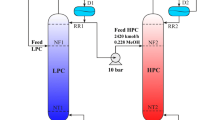Abstract
The separation of methanol-chloroform mixture, a minimum-boiling azeotrope, is performed using pressure- swing distillation process via process simulation. In this study, the steady-state optimization was carried out using PRO/II with PROVISION v.10. The two different column configurations (low-to-high pressure and high-to-low pressure) were compared wherein the positions of the low-pressure column and high-pressure column were operated interchangeably to attain an optimized design. Additionally, different heat-integration configurations (partial heat- and full heat-integration) were applied to lessen the overall utility consumption. It was determined that the low-to-high pressure column configuration provided a more optimized result for all heat-integrated systems as compared to high-tolow pressure column configuration. Application of heat-integration further decreases the cooling water and steam consumption by 38.86% and 35.74%, respectively, for partial heat-integrated system, and by 44.58% and 41.01%, respectively, for full heat-integrated system.
Similar content being viewed by others
References
C. L. Schengrund and P. Kovac, J. Lipid Res., 40, 160 (1999).
K. H. Row and Y. Jin, Bioresour. Technol., 97(5), 790 (2006).
R. Van Kaam, I. Rodriguez-Donis and V. Gerbaud, Chem. Eng. Sci., 63, 78 (2008).
H.-J. Kang and J.-H. Kim, Korean J. Chem. Eng., 36(12), 1965 (2019).
J. Gmehling, J. Menke, J. Krafczyk, K. Fischer, J.-C. Fontaine and H.V. Kehiaian, Fluid properties. in: Handbook of chemistry and physics, 92th Ed., CRC Press, Boca Raton (2005).
J. A. Dean, Physical properties. Lange’s handbook of chemistry, 15th Ed., McGraw-Hill, New York (1999).
P. Langston, N. Hilal, S. Shingfield and S. Webb, Chem. Eng. Process., 44, 345 (2005).
Y. Wang, G. Bu, Y. Wang, T. Zhao, Z. Zhang and Z. Zhu, Comput. Chem. Eng., 95, 97 (2016).
E. Hosgor, T. Kucuk, I. N. Oskal and D.B. Kaymak, Comput. Chem. Eng., 67, 166 (2014).
Z. Lei, B. Chen and Z. Ding, Special distillation processes, Elsevier, Amsterdam (2005).
Q. Li, L. Cao, Y. Zhang, P. Liu and B. Wang, J. Chem. Eng. Data, 59, 234 (2014).
T. Hiaki, K. Kurihara and K. Kojima, J. Chem. Eng. Data, 39, 714 (1994).
I. I. Vasil’eva, A. N. Marinichev and M. P. Susarev, Deposited Doc. VINITI, 3400–83 (1983).
I. Nagata, J. Chem. Eng. Data, 7, 367 (1962).
A.M. Fulgueras, D. S. Kim and J. Cho, Korean J. Chem. Eng., 33(1), 46 (2016).
J. Lee, J. Cho, D.M. Kim and S. Park, Korean J. Chem. Eng., 28(2), 591 (2011).
X. Gao, X. Yin, S. Yang and D. Yang, Korean J. Chem. Eng., 36(1), 77 (2019).
W. L. Luyben and I. Chien, Design and control of distillation systems for separating azeotropes, Hoboken, New Jersey (2010).
W. L. Luyben, Distillation design and control using aspen simulation, 2nd Ed., Hoboken, New Jersey (2013).
J. Cho and J.-K. Jeon, Korean J. Chem. Eng., 23(1), 1 (2006).
Acknowledgement
This work was supported by the research grant of the Kongju National University in 2019.
Author information
Authors and Affiliations
Corresponding author
Ethics declarations
The authors declare that there is no conflict of interest regarding the publication of this manuscript.
Rights and permissions
About this article
Cite this article
Galanido, R.J., Kim, D.S. & Cho, J. Separation of methanol-chloroform mixture using pressure-swing distillation: Modeling and optimization. Korean J. Chem. Eng. 37, 850–865 (2020). https://doi.org/10.1007/s11814-020-0505-6
Received:
Accepted:
Published:
Issue Date:
DOI: https://doi.org/10.1007/s11814-020-0505-6




